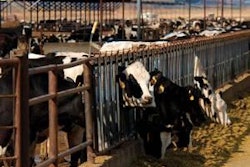.jpg?auto=format%2Ccompress&q=70&w=400)
A Spanish mill uses extrusion routinely in its farm feed production, as part of a process that cooks the components of the diet to enhance their digestibility for baby pigs. At a time when Spanish researchers are leading an international examination of whether the nutritional value of soybean meal varies significantly according to the country of origin, the plant has also joined the debate by reporting recent trial results in favour of using home-cooked soya protein rather than purchased supplies.
This Provimi-owned factory, called SCA Iberica, stands close by the border between the regions of Aragon and Cataluña in eastern Spain. It is therefore at the heartland of Spanish pork production, with more than half a million sows located within a 100-kilometre radius. In fact, pig producers represent its only clientele since it is devoted exclusively to manufacturing piglet feeds.
"We have by far the largest market share in Spain for creep diets to feed to baby pigs," comments general manager Xavier Bosch. "That is where we are most dominant, involving the first 1-1.5kg of solid food eaten by the piglet. Even in the area of pre-starters that have a consumption of about 5kg per pig we are probably number two for size in this country. It is not until the next 15-20kg of consumption per pig that we have more competitors among the compound mills as well as the other specialists like ourselves."
Out of more than 8 million tonnes of pig feed made in Spain each year, he points out, the annual volume for piglets comprises up to 500,000 tonnes. The country's major integrators in pork have become accustomed to sourcing these from specialty mills even when they have their own plants manufacturing blends and compounds. It was a key factor in the decision by the company in 1999 to invest in constructing a new factory at Mequinenza, in the district of Zaragoza, with the capacity to produce up to 50,000 tonnes of piglet feeding products annually.
Today the mill works on a one-way flow system from raw material reception through manufacturing to the clean zone for finished products. All macro-ingredients are reduced to a 1-1.5mm particle size to be more digestible to baby pigs and also to achieve some increased intake in the first week of solid feeding. After the two-tonne mixer, every mixture is pelleted to a 2mm diameter.
However, today's mill differs in various ways from its initial form. One significant change has been to add to raw material storage choices. When the site started its first commercial production in 2000, it was equipped with 16 mechanically filled bins and bagged ingredients were tipped by hand. Now there are 64 silos for raw materials and the transfer into them is almost entirely automatic.
"We needed the extra storage capacity because we work with so many ingredients," comments production director Carlos Puyal. "At our last count we found we were using up to 150 raw materials. I say that my job is like managing a restaurant. We have a menu of multiple formulations for every customer, driven by the fact that everyone wants a different medication or even a different recipe. Our first requirement as a specialist factory is therefore to be flexible, willing to tailor-make diets according to the customer's wishes."
Flexibility means having a wider range of ingredient options and the capability of manufacturing diets in relatively small amounts as well as in longer runs, he adds. Putting in another 48 silos might in theory have increased the possibility for an accidental confusion of materials, but this has been avoided in practice by making full use of barcode registration of materials for stock control and traceability.
Each incoming delivery on arrival is allocated a barcode label that links to an identification system with the vehicle's registration number, the supplier and a categorisation for the type of product as well as details of the consignment order. The identity information found by the barcode reader at the intake then automatically directs the load to its pre-selected bin after normal quality control checks have been performed. At the other end of the process a barcode is similarly printed for the final product and this authorises the opening of the correct out-take bin out of the 17 available for bulk storage.
"We also pack in 500kg-1 tonne big bags, but bulk is an increasing part of our business," says Xavier Bosch. "The mill started with eight finished product silos, each of 54 tonnes. This was increased to 17 bins by adding nine of 12-tonne capacity. All our customers collect feeds in their own trucks and some of those vehicles can be divided into three to four compartments, so it made sense to have smaller storage units to suit them. In fact, if we were building the factory today, probably the only thing we would do differently would be to cut down on silo size."
Within the past year, the Mequinenza site has been given a further update in the form of equipment for the automatic addition of micro-ingredients into the mixer. This has also brought extra weighing equipment. Originally there were three scales (two of 2 tonnes and the other for 500kg) to service the 16 macro-ingredient bins. Three new scales two are of 25kg size and another of 400kg have been added during 2006 with the arrival of the automatic micro-ingredient system.
The installation of its cooking line was completed earlier, in 2004, at a cost of approximately 900,000 including the controls. First the materials from the grinder are received into a vertical conditioning tank where they are exposed to steam for a temperature of 100o C, during the 20-25 minutes that the constant flow of product takes to move down through the tank's two floors. Most of the cooking process therefore takes place in the conditioner even before the material undergoes extrusion. The machine for that last step is a Kahl expander, although its operators say it is a hybrid run with the philosophy of an extruder in the sense that the lightest setting is used for the control of temperature by differing die length and pressure.
SCA consultant Eric Hindson supervised the mill's design and construction. He explains that SCA Iberica always intended its new plant to cook materials. The machinery had been included in the blueprint drawn up in 1999, he comments, only its implementation was delayed for budgetary reasons. But he also remarks that the factory had no other option in practice than to become involved in cooking because of continuing difficulties in obtaining top-quality cooked soya products on the open market. Purchased meal could be poorly heat-treated, hard to handle due to problems such as sticking in silos and even susceptible to Salmonella contamination.
The payback from the cooking line investment has come in better results, the Mequinenza directors report. The conclusions suggested by comparing components at the mill's own experimental farm have been supported by recent trial work in which the piglet diets differed only for soybean meal source. Simply changing to meal from the conditioner-extruder process instead of the soya supplied by a big multi-national source brought such an improvement in growth rates that the pigs weighed half a kilogram more on average by the time they were 60 days old.

















